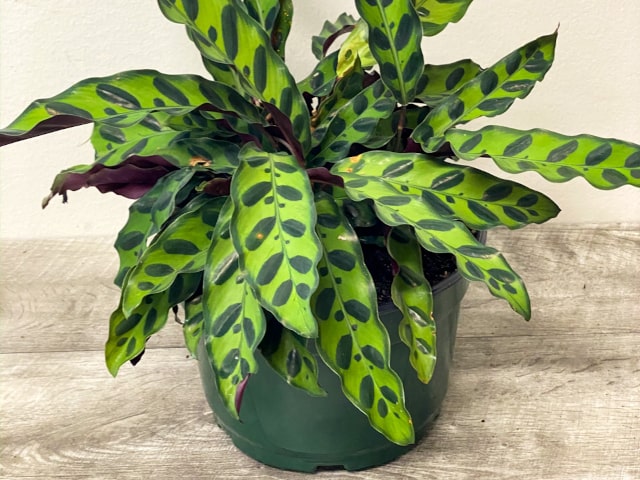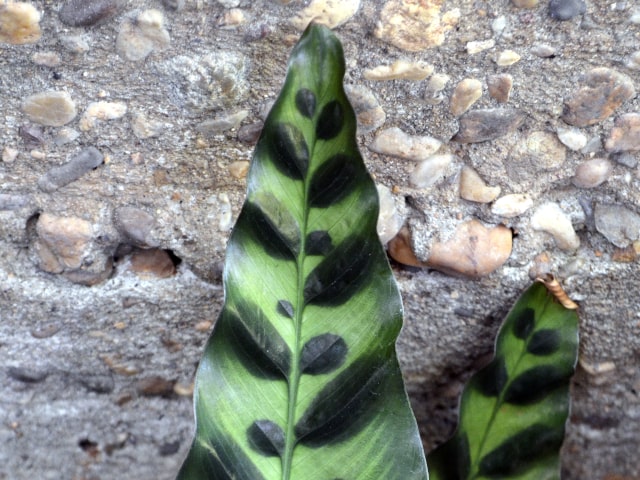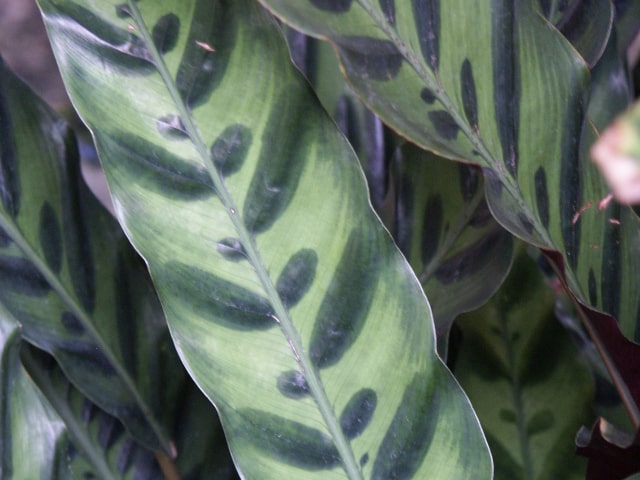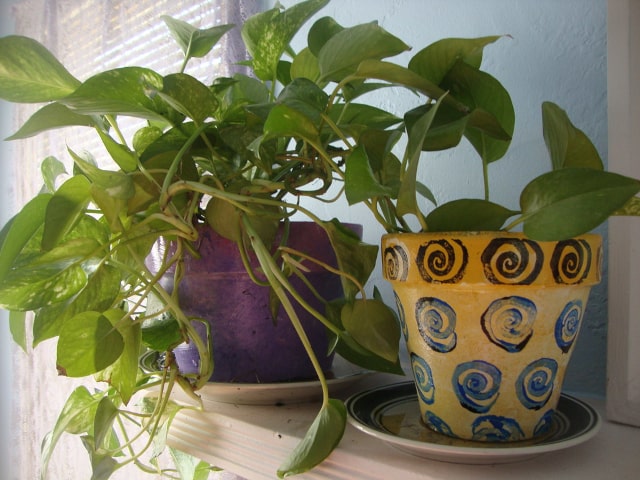
Rattlesnake plant, scientific name Calathea lancifolia, is a popular variety of the Calathea plants. It is great for those who wish to have a tropical vibe in their home. This is a great plant to grow for its magnificent foliage.
Just like other varieties of Calathea plants, this one is a bit demanding. As such, it is not a perfect choice for beginner gardeners and those who want to spend less time caring for their plants. However, if you wish to invest some time and energy you will sure be rewarded. Rattlesnake plant is gorgeous and can truly improve the look of your home.
A good thing about the Rattlesnake plant is that, while it can be a bit demanding, it is actually less demanding than other common Calathea varieties. It means this plant is suitable for those who want to grow a Calathea in their home but do not want to have a plant that is too demanding or difficult to care for.
Basic Rattlesnake Plant Facts
Rattlesnake plant (Calathea lancifolia) is often sold under the name Calthea insignis, which is the plant's former scientific name. Keep this in mind when you go shopping for a Rattlesnake plant in a nursery or garden center.
This plant is native to Brazil. In nature, Rattlesnake plant lives in warm and moist areas of the rainforest. It needs plenty of warmth and moisture to thrive. At the same time, it doesn't do well in strong, direct light so this is something to keep in mind.
In its natural habitat, Rattlesnake plant blooms in late spring and early summer. However, it is not likely to bloom indoors so these plants are mainly grown for their gorgeous foliage.
This is a relatively tall plant. The leaves can grow to be more than 30 inches tall. A good thing about the Rattlesnake plant is that it's not toxic to pets (cats and dogs). It means you can grow it in your home alongside your pets without any fear that the plant might harm them.
Gorgeous Foliage
Just like most of the other varieties of Calathea plants, Rattlesnake plant has gorgeous foliage. This is the main reason people choose to grow it in their homes.
The leaves of the Rattlesnake plant are marked with various shades of green. The undersides of the leaves are reddish and purple, which also contributes to the plant's beauty. The leaves have wavy edges that only emphasize the markings and the beauty of the leaves. Many Rattlesnake leaves have green spots that look like small leaves.
How to Care for a Rattlesnake Plant
Since this plant is native to tropical regions of Brazil, it requires plenty of warmth and moisture. It means it can't do well in dry, cold areas. If you put your Rattlesnake plant in a room full of cold and dry air, below temperatures of 50 degrees F (10 degrees Celsius), it will get harmed. The most common problem you may encounter if it's too cold and dry is the loss of leaves. You may notice your Rattlesnake dropping leaves or you may see brown spots on the leaves.
At the same time, keep in mind that the Rattlesnake plant is very resistant to the browning of the leaves. Unlike other Calathea plants, that easily develop brown spots, this doesn't happen so often with a Rattlesnake plant. If it does happen it is a sign that something is seriously wrong and that you need to change the care regime. Most of the time, this problem develops due to coldness and low humidity.
The best way to make your Rattlesnake thrive is to plant it in a slightly sandy soil that allows for good water drainage. Make sure to keep your plant away from direct sunlight. Too much bright light is not good for your Rattlesnake plant. It will also make the leaves fade and lose those bright markings, which may affect the plant's appearance. The best place for a Rattlesnake plant is an indoor patio or a room in your home near a window that doesn't get much direct sunlight.
Keep in mind that Rattlesnake is a somewhat demanding plant, just like other Calathea varieties. However, among Calathea plant, this is probably the least demanding of them all. It means that it's not so difficult to care for it, unlike other Calathea plants. Beginner gardeners interested in Calathea plants should probably go with a Rattlesnake plant because it's much easier to care for than the other Calathea varieties.
However, keep in mind that you should never neglect or mistreat your Rattlesnake plant for too long. It may seriously harm your plant. Make sure to provide it with all the essential care conditions it needs to thrive:
- Soil. Your Rattlesnake plant will thrive in potting soil that is 2 parts peat and 1 part perlite. It is important to choose a potting soil that can retain some moisture while also providing good drainage. However, make sure not to use too much drainage materials because it will make the soil lose moisture quickly. You should replenish the top part of the soil in the spring months. It will allow the plant to get fertilizer properly and to benefit from all the nutrients.
- Light. This plant needs bright light but not direct light. As such, it's best to keep it in a bright spot in a room that is away from direct sunlight.
- Temperature. Rattlesnake plant thrives in temperatures between 65 degrees F and 75 degrees F (18 to 24 degrees Celsius). Make sure never to keep your Rattlesnake plant in a room that has a temperature lower than 60 degrees F (15 degrees Celsius). You should also make sure to avoid cold drafts and any sudden temperature changes.
- Humidity. This is a plant that loves moisture, just like other varieties of Calathea. You can try misting the leaves to improve humidity but Rattlesnake plants actually prefer a tray with water. Simply place a tray with pebbles and water under the pot. It will help holding the moisture and increase the humidity levels. If this doesn't work, consider investing in a humidifier.
- Watering. You need to water your Rattlesnake plant frequently during the growing season, from May to August in particular. It is important to keep the soil moist, but never allow your plant to sit in water. Cut the watering down during the winter months. Only water when the top of the soil becomes dry to the touch.
- Fertilizing. Make sure to fertilize your plant regularly with a balanced liquid fertilizer. Feed your plant once per month in the period from April to August. Fertilizer will improve the health of the foliage and make the leaves stronger and more impressive.
Rattlesnake Plant Repotting and Propagation
It is important to repot your Rattlesnake plant from time to time. As the plant grows, you will need to move it to a wider pot so the new stems and roots have enough room to grow. This is best done in spring. You will need to repot your Rattlesnake plant every year or every two years.
If the plant grows really big you may consider propagating it. Rattlesnake plants are best propagated by division. This should be done at the same time as repotting. Simply divide the plant by half or more segments and plant each segment into a separate pot. Make sure to carefully separate the stems of the each plant.
After repotting the segments, make sure to water properly but then give segments some time between watering to develop a new growth. Wait until there is new growth to start watering again.
Common Problems with Rattlesnake Plants
Here are some common problems with Rattlesnake plants you may encounter:
- Leaves yellowing. This happens often with older leaves and is natural. However, if too many leaves become yellow it might be a sign of over-watering.
- Brown spots on leaves. Sometimes, you may notice brown spots on the leaves, particularly on the tips of the leaves. This is commonly caused by air that is too dry and it's a sign that your plant needs more humidity.
- Curling of the leaves. This is a common sign that the plant is under-watered. Increase water and make sure to water properly. Another common cause of this problem may be air that is too dry. In this case, try increasing humidity levels around your plant.
- Limp stems. Sometimes, your Rattlesnake may develop limp stems. This can be a serious issue that happens if the plant grows in a cold environment, especially if you over-water it. This can be very dangerous for the plant so you need to move it to a warmer spot immediately.




19 Comments
Hi there, I have done everything (except fertilize). I thought it might be the chlorine in the tap water. Well problem solved. I live in the high desert, very dry climate. This plant like humidity - ha!
Cheers and thanks for the info!
Why is it called Rattlesnake Plant?
My daughter surprised me with this BEAUTIFUL plant for Mother's Day this year. However, I've been struggling keeping keeping leaves open. I've sprayed it with distilled water as opposed to tap water and placed it near a window. I hate to see it drying up. I also went as far as placing it in the bathroom and running the shower for humidity. What type of fertilizer should I use and how often?
You have been a big help for me. They are the stubborn plant I've ever had. I have it outside on my patio on the doorstep. It doesn't get direct sunlight just light and not much. I'm not giving up or let it get the best of me. I just repotted in in a much wider pot and fresh miracle grow dirt. I don't have to fertilize it for 3 mos so it said on the bag, but I will fertilize once a month and water when needed. Thanks again for all your hints and suggestions!
Have a wonderful Summer and I will keep you posted!!
Margie
I've noticed my lovely Rattlesnake Plant also wakes up before there's any light. It's sleep habits are a bit mysterious.
They go to sleep at nite. Its coolest thing ever!
Very thorough instructions. What brand of liquid fertilizer do you recommend?
It's like a Prayer Plant closing up at night.
It also called a Prayer Plant like all Calatheas varieties
I having a problem with my plant. I been noticing that the Rattlesnake Plant is not closing up at night. What causes that?
Should never have bought this plant. Sounds too demanding but it's good to have a challenge.
So a friend gave me this plant last year. It looked pretty sad. So I've been trying to revive it. There are brown spots all over and I'm not sure what to do. Should I cut all the brown spotted leaves or what?
I bought this cuz of the plant sleep patterns. I was told that it goes to sleep. That's the closing up the leaves and back down. I was trying to figure out if it's the moon cycle or what. Cuz it starts to sleep before dark and even when there is light in the house. Just like on a dark rainy day. It knows it's daytime. The indoor temperature is constant so it's not the temp. Fun to watch.
Nowhere in info on the Rattlesnake Plant
I purchased does it say what happens.
In the daytime it spreads out its beautiful green with darker green spots but slowly in the nighttime the leaves go straight up and shows the wine colored back of the leaves. It's like two different plants cause by the morning the leaves go back to laying out flat with no backs (wine) showing. Love it!